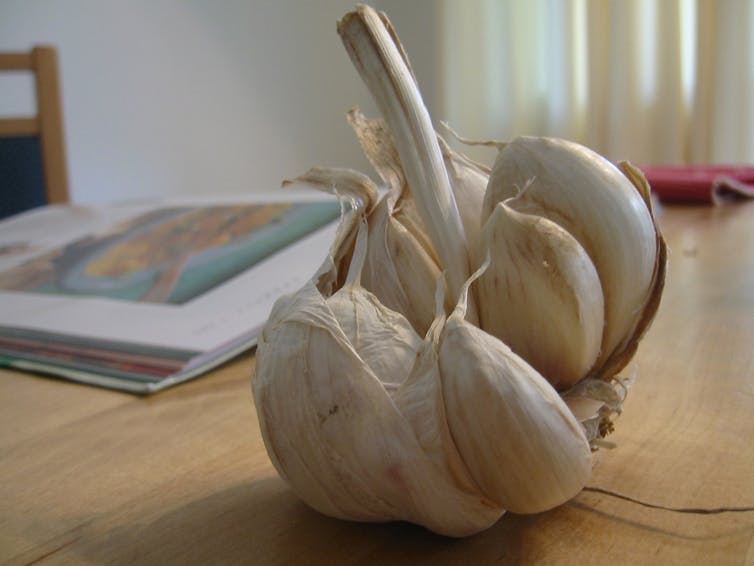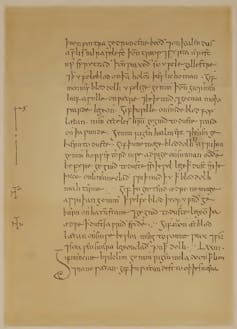It’s not often that medievalists get as excited as they have been over the revival of a medieval remedy for eye conditions involving garlic, onions, wine and ox gall, prepared in a bronze vessel. The concoction, mixed up by a team from Nottingham University, appeared to show promising results in the battle against MRSA. It didn’t kill it all, but it apparently killed 90%. This has revived enthusiasm for trawling ancient texts for the solutions to modern problems.
The remedy comes from Bald’s Leechbook, a 10th-century manuscript, and the powers of the separate ingredients of the remedy have been known for some time: garlic has anti-fungal, anti-viral, anti-parasitic and anti-microbial qualities.
The idea of subjecting medieval recipes to modern methods of testing is also not new. In 1993, in his book Anglo-Saxon Medicine, the biologist ML Cameron singled out this very remedy as “an outstanding example of a remedy likely to have been helpful”. And it was this same remedy that was reconstructed by a team from Wheaton College, although their results, published in 2005, found that it had no effect.

They concluded that “some of the Anglo-Saxon recipes take biologically efficacious ingredients and process them into ineffective mixtures”. So while the garlic would work on its own, the compound remedy prepared over nine days, wouldn’t.
The 2005 research was part of a rehabilitation of the Anglo-Saxons, which aimed to show they were considerably more learned and deserving of more respect than had previously been thought. But, for the Wheaton College team, the remedies did nothing to support that view.
The problem with revival
There are also some serious problems with the new, more positive, claims for the eye salve. And these apply to all such attempts to rediscover ancient remedies.
First, can we really identify the ingredients? For the eye remedy for example, the Anglo Saxon word “cropleek” found in the ingredients can mean leek, garlic or shallot, or perhaps a specific part of a leek. Websites that have attempted to translate the remedy have also listed onions. So what plant should a modern researcher select for their trials? And do modern plant descendants have the same properties now as their ancestors did?
Second, in compound recipes, how do we know which ingredients are worth testing? Descriptions of 10th-century medicine sometimes suggest that we can easily decide which ingredients are “improbable” and which are “feasible”. An example seen as combining the two is a remedy for a burn including “silver filings, bear’s grease, thyme, rose petals and verbena”.
From a modern perspective, bear’s grease is unlikely to differ from other animal fats or have any health benefits beyond acting as a lubricant or protective barrier.

Third, what’s the medical problem that the remedy in the Leechbook is designed to treat? One announcement of the discovery suggests that the many conditions it could treat are “clearly bacterial infections (weeping wounds/sores, eye and throat infections, skin conditions such as erysipelas, leprosy and chest infections)”. But is that really “clear”? We could decide that if pus is mentioned, then there must be an infection.
But even here we need to be sensitive to different beliefs about the body. The history of medicine includes the concept of “laudable pus” – pus which is a good thing, a stage of healing rather than a complication. This idea was still around in 1916 but there was always debate over this – even in the Middle Ages.
Some scholars interpret the condition for which the eye salve is used as being a stye, but a stye is normally self-limiting and so goes away regardless of what is put on it.
Flying venom, hidden nightgoers
In many cases we can’t really match a modern diagnosis to an ancient one. Bald’s Leechbook also offers us “a salve against elf-kind and nightgoers, and the people with whom the devil has intercourse”. Or what about the Anglo-Saxon condition called “flying venom”?

In the ancient Greek medical tradition, the wandering womb was a condition. If we analyse remedies for the wandering womb in terms of their ingredients, what do we get? Puppies stuffed with aromatics feature in fumigations. Garlic was also used. If we study the chemical constituents of ancient remedies and if one ingredient turns out to be antibacterial, then does that mean we have to conclude that the wandering womb was an infection? But if we decide that, then what do we do about those puppies?
Ancient medicine to the rescue?
So I remain a sceptic here, especially when the announcement of the remedy remade came at the same time as a crowd-sourcing appeal for a tiny sum to pay for an undergraduate student to help out in the lab.
Even more importantly, we see a mixture of arts and science academics on the video. Teamwork is certainly important. As is the very real threat to humanities subjects in the face of science, technology, engineering, and mathematics (STEM) funding.
Maybe that’s why so many in the arts and humanities seem to be enthusiastic about the eye disease remedy. But while it’s interesting that ancient remedies can be put together, ultimately there’s a danger that we simply replace the view that the only medicine worth knowing about is what we have today, with a misguided idea that the past holds all the answers.

